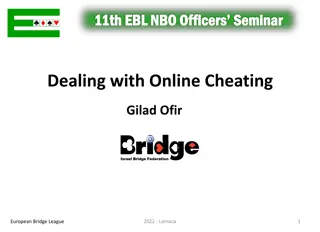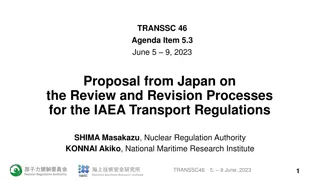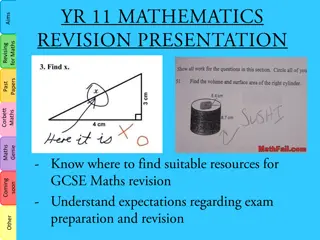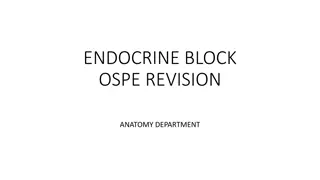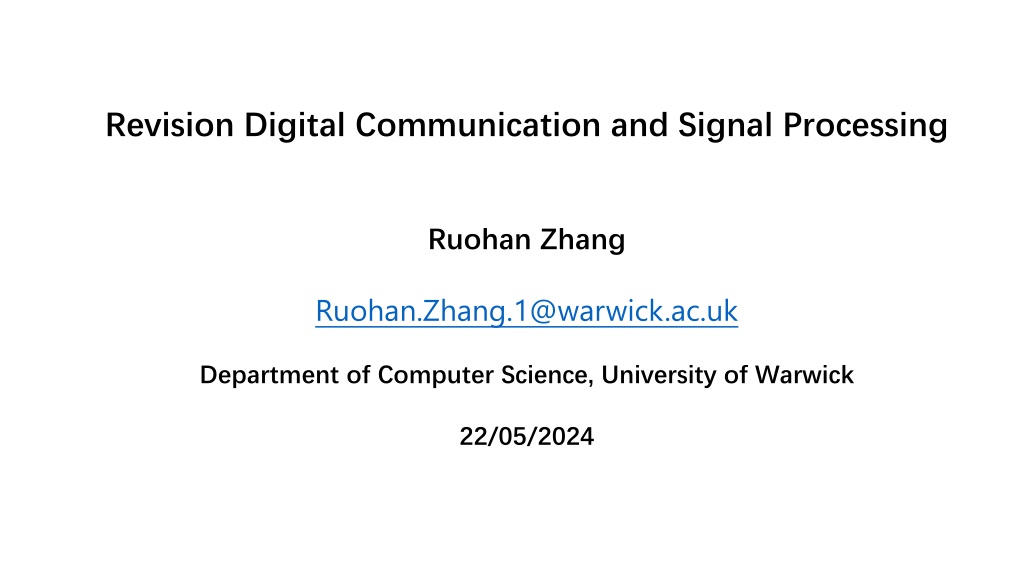
Advanced Signal Processing Techniques Explained
Explore topics like Wiener and Kalman Filters, Exponential Fourier Transform, and Noise analysis in digital communication and signal processing. Learn how to design filters, calculate Fourier transforms, and analyze noise characteristics of signals.
Download Presentation

Please find below an Image/Link to download the presentation.
The content on the website is provided AS IS for your information and personal use only. It may not be sold, licensed, or shared on other websites without obtaining consent from the author. Download presentation by click this link. If you encounter any issues during the download, it is possible that the publisher has removed the file from their server.
E N D
Presentation Transcript
Revision Digital Communication and Signal Processing Ruohan Zhang Ruohan.Zhang.1@warwick.ac.uk Department of Computer Science, University of Warwick 22/05/2024
1. Wiener and Kalman Filter Suppose that we received an incoming signal {?[?],? = ?, 1,0,1, ,?}. (a) If you want to design a Wiener filter to denoise it, the Wiener filter should be defined by ?[?] = ??+ ??(?[?] ??) find out the coefficients ??and ??. (b) Comment on how the window size in (a) affects the final outcome after applying the Wiener filter to the signal.
Answers: 1 ? ??(?), ??=?2? ??2 (a) ? = where ? is the local variance,??2is the global variance. ?2(?) (b) Large N reduce noise, but blur the signal; small N will not affect noise; optimal size should be used.
2. Exponential Fourier Transform Assume that we have a periodic signal ?(?) with a period ?. The Fourier Transform of ?(?) can be expressed in the following two ways ?(?) = ?0+ ?=1 ??cos(???) + ?=1 ??sin(???) And ?(?) = ?= ??exp(????) (a) Based upon the property that {1,cos(???),sin(???),? = 1,2, } are orthogonal, work out the formula to calculate ?0, ??, ??, ? = 1,2,3 (b) Work out the relationship between ??, < ? < and ?0, ??, ??, ? = 1,2,3,
Answers (a) ?0= < 1,? ? > = 1/? ?/2 ??= < cos(???),? ? > = 2/? ?/2 ??= < sin ??? ,? ? > = 2/? ?/2 ?/2? ? ?? ?/2?(?)cos(???)?? ?/2?(?)sin ??? ?? (b) ?(?) = ?0+ ?=1 = A0+ ?=1 = ?0+ ?=1 = ?= ??cos(???) + ?=1 ??exp ???? + exp ???? /2 + ?=1 [ ??2 ??(2?)]exp ???? + ?=1 ??exp(????) ??sin(???) ??exp ???? exp ???? /(2?) ??2 + ??(2?)]exp ???? [
3. Noise Assume that we have two signals ?[?], ?[?] taking the following form ?[? + 1] = ?[?],? = 1,2,3, ?[? + 1] = 0.2 ?[? 2] + ?[?],? = 1,2,3 where ? [?] is independent and normally identically distributed with mean zero and variance 1. ? ? ,? = 0,1,2, have identical normal distribution. (a) Work out the mean, variance, and distribution of ?[?].
Answers: ???? ? ? + 1 = ???? 0.2 ? ? 2 + ? ? mean(? ? ) = 0.2*mean(? ? ) + mean(? ? ) 0.8*mean(? ? ) = mean(?[?]) = 0 mean(? ? ) = 0 var ? ? + 1 = ??? 0.2 ? ? 2 + ? ? var(? ? ) = 0.22*var(? ? ) + var(? ? ) (1 0.22)* var(? ? ) = var(?[?]) = 1 1 var(? ? ) = 1 0.22= 1.042 ?~?(0,1.042)
4. Coding Let ? = {??,? = 1, ,?} be an information source and its corresponding probability is ??= ? ??, ? = 1,2 ,?. (a) Assume we have event {?,?} with probability ?(?) = 0.2 and ?(?) = 0.8. The sequence as shown in Table 1 are coded using the Huffman code. Fill in Table 1 and explain in detail how you created the Huffman tree and the results you obtained. Measure the average code length and entropy. Sequence NNN NNR NRN RNN RRN RNR NRR RRR Probability Codeword Codeword Length (in bits) Weighted code length
Answers: The average length is 2.12. The entropy is 2.1658.
5. You want to design a recursive digital filter of the form ? ? = ? 0 ? ? + ? 1 ? ? 1 + ? 2 ? ? 2 + ? 1 ? ? 1 + ? 2 ? ? 2 to remove a narrowband disturbance with frequency ?0= 15??. Let ??= 60?? be the sampling frequency. (a) Work out the transform function of the filter. (b) Determine the coefficients ?(0), ?(1), ?(2), ?(1), ?(2) with the additional constraint that ?(?)=1 when ?(?)=1 for all ?.
Answers: ? ?1 ? ?2 ? ?1 ? ?2. (a) The transfer function is ? ? = ? ?0 ?? =? We have ?0= 2? 2. Because we want to stop the disturbance, we must have ?(? ??0) =0. This can be achieved by placing the two zeros at ?1= ???0= ?, ?2= ? ??0= ?. We can choose ?1= ????0= ??, ?2= ?? ??0= ??, with ? 1 but smaller than 1, then, obtain ? ? = ??2+ 1 ?2+ ?2
?(?)?=1= 1, which gives ? =1+?2 (b) The value of the gain can be determined by requiring that 2. Then, we obtain ? ? =1+?2 ?2+1 ?2+?2. 2 ?2 ?1+?2?+?1?2 ?2 ?1+?2?+?1?2=? ? ?1+?2? 1+??1?2? 2 By multiplying the factors in ?(?), we get ? ? = ? 1 ?1+?2? 1+?1?2? 2. On the other hand, by z-transforming Equation ? ? , we get ? ? =?0+?1? 1+?2? 2 1 ?1? 1 ?2? 2. Thus, by comparing these two equations and the additional constraint that ?(?)=1 when ?(?)=1 for all ?, we get ?0= ?, ?1= ?(?1+ ?2), ?2= ??1?2, and ?1= ?1+ ?2, ?2= ?1?2. In our case, this gives ?0=1+?2 2, ?1= 0, ?2=1+?2 , and ?1= 0, ?2= ?2. 2 So, we finally obtained ? ? =1+?2 + ?2? ? 2 . ? ? + ? ? 2 2











